King Arthur Flour’s Magazine Sift featured a version of our recipe here.
I’m a baker. I enjoy cooking – even more so now that we’re back in soup season – but to me there’s something special about the precise measurements that produce a perfect chocolate cake, the fiddly steps of making italian meringue frosting, the flexibility of quick bread recipes, the scooping and rolling of cookies. So I’m especially interested in the many recipes for baked goods scattered throughout the archive of recipe books we’ve been exploring. These “Desart Cakes” caught my eye – what characterizes a dessert cake? Is it not a cake but, like the snickerdoodle-esque Shrewsbury cakes, what we think of as a cookie? Could they even make the cut for my holiday cookie gift bags?
The recipe comes from UPenn Ms. Codex 1038, a fairly general compilation of recipes put together through the late eighteenth and early nineteenth centuries. This particular recipe was probably written down before 1793. Marissa also whipped up and enjoyed a batch of lemonade from the same volume here. (In fact, these recipes occupy facing pages. Lemonade and cookies, anyone?)
The Recipe
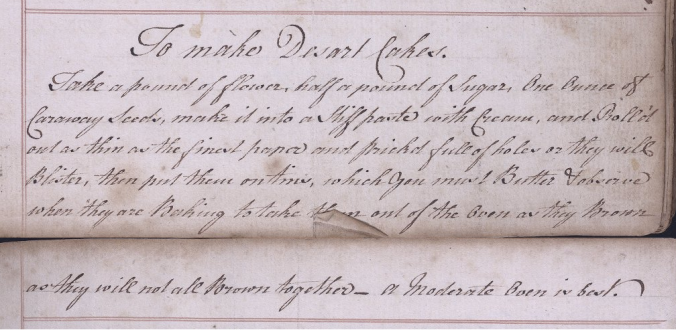
To make Desart Cakes.
Take a pound of flower, half a pound of Sugar, One Ounce of
Caraway Seeds, make it into a Stiff paste with Cream, and Roll’d
out as thin as the finest paper and pricked full of holes or they will
Blister, then put them on tins, which you must Butter & observe
when they are Baking to take them out of the Oven as they Brown //
as they will not all Brown together — a Moderate Oven is best.
Our Recipe
[If I’m not sure how a recipe is going to turn out, I like to avoid making an enormous quantity of it. Cookies make that easy: here, I halved the recipe. which yielded 44 2″ cookies. Plenty!]
1/2 lb. flour
1/4 lb. sugar
1/2 oz. caraway seeds (about 3 tsp.)
1 1/4 c. heavy cream*
optional: 1/2 tsp. vanilla**
In a mixing bowl, stir together the dry ingredients. Stir in the vanilla and the cream about 1/2 c. at a time, incorporating it thoroughly before adding the next pour. (A wooden spoon works nicely here.) The dough should start to hold together in a shaggy mass damp enough to be squeezed gently into an elastic, cohesive ball. (It shouldn’t be so damp that it sticks to your fingers at all – this isn’t a particularly messy dough. If this does happen, just add a touch more flour.) ]
Preheat oven to 350F.***
Divide the dough into halves or thirds for rolling out easily. Lightly flour your surface and rolling pin; you won’t need too much flour, but repeat the step often to avoid sticking. Roll to about 1/8″ thickness – thinner if you can since the dough shrinks back slightly once on the cookie sheets. Cut out dough with any cookie cutter**** and place on a baking sheet. (I lined mine with parchment paper.) Bake for 10-12 minutes, removing cookies as they brown around the edges. Cool on a rack – and try not to eat one as soon as it’s semi-cool!
NOTES:
*How much cream to add: I added 1/2 c. to start with and then more in 1/4-c. increments until the dough held together and felt slightly elastic when squeezed in a handful. My dough was wetter than biscuit dough or pie crust, for example. It should be wet enough to hold together easily without bits crumbling off but not so sticky that it adheres to your hands.
**Adding vanilla: I thought vanilla might add some nice depth of flavor with the caraway seeds, and I think I was right. In fact, next time I might add the full teaspoon. You could also try almond extract, orange extract, or skip the extract altogether. Or even switch out the caraway seeds for poppy seeds and toss in some lemon zest. It’s a flexible recipe.
***Baking temperature: I baked one sheet at 325F for 14-16 minutes and another at 350F for 10-12 minutes. I didn’t notice any difference in browning or in crispness produced by the different temperatures, so less time at 350F should be fine. You’ll start to smell the cookies when they’re nearly done; I removed them from the oven when golden-brown on the bottom and slightly browned around the edges. I also forgot to prick holes in the first tray (oops). I did add them to the second but didn’t note any difference (or “blistering”); feel free to stab them a few times with a fork if yours seem to be puffing up.
****Cookie cutter: I chose and liked a 2.5″ biscuit cutter with fluted edge, but most shapes would work, as would the top of a drinking glass. As mentioned, the dough does shrink a bit on the cookie sheet and then in the oven – none of my circles baked up to be perfectly even, and the caraway seeds make for somewhat ragged edges, so avoid any intricate shapes.
The Results
I thought these might be bland – inoffensive, sure, but not particularly tasty – and so was pleasantly surprised at how much I enjoyed them. They’re nicely crisp (rolling them “as thin as the finest paper” really does produce the best result), sweet without being cloying, and flavorful from the caraway seeds. Plus, they smell incredible while baking! I ate the first few with a cup of tea … and then a few more later on with a glass of wine … and then a few more for breakfast the next morning in a pinch. If you like caraway seeds, you’ll like these. And if you don’t like caraway seeds, you can still like these cookies by swapping them out for poppy seeds or another variation. I might experiment with adding in some ground almonds or pistachios. (If you do some experimenting, please report back!) And indeed, some of these might even make their way into my holiday cookie rotation.
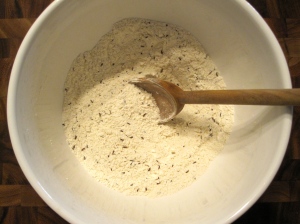
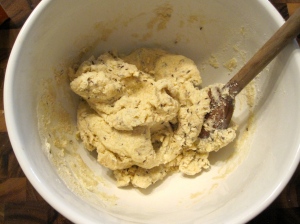
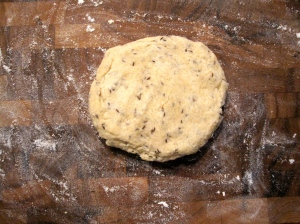
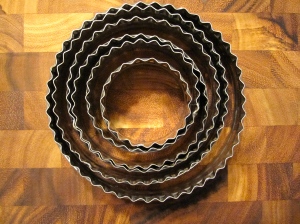
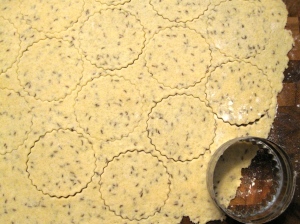
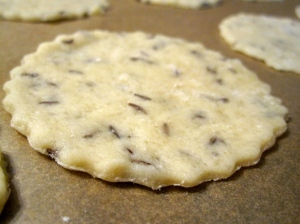
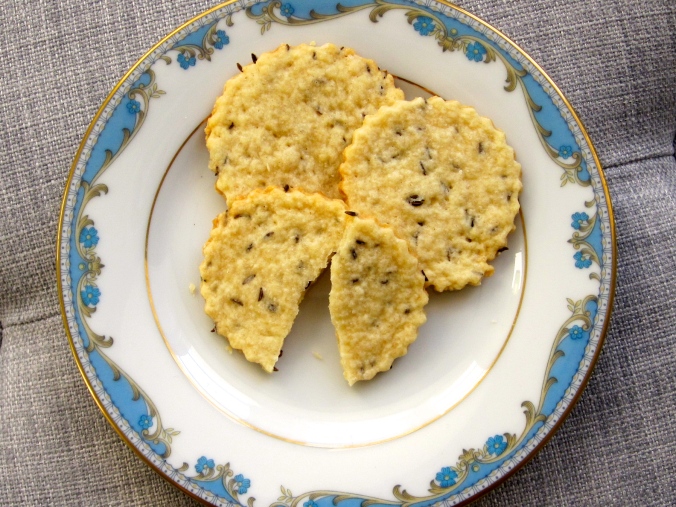
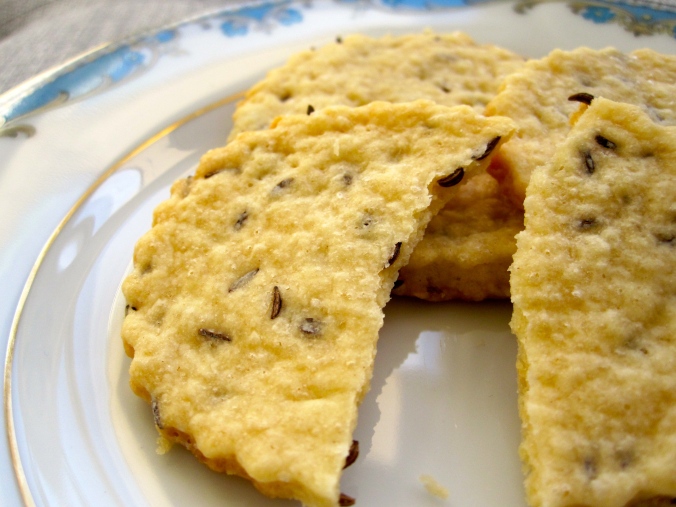
For the holidays (season of springerle!) I would suggest anise seeds 🙂 – tekla
Tekla, that’s a great idea accidentally left out through personal prejudice: I’m coming around to anise, but only gradually and in very small doses. For anise enthusiasts, these cookies would be perfect.
Were they similar to bene wafers?
I’d never even heard of benne wafers before your question prompted me to look up a recipe – they sound delicious. I suspect that the butter and eggs in the wafers give them a shinier, crispier, somewhat richer finish. These cookies taste almost like scones in cookie form (because of the heavy cream). I’ll have to add the wafers to my experiment list! Thanks for the suggestion.
Reblogged this on DailyHistory.org and commented:
Cooking in the Archives has a new recipe – Desart Cakes. Desart cakes are a wonderfully thin and crispy cookie. The recipe is remarkably simply and straightforward. Alyssa suggests some solid substitutions (poppy for caraway seeds) and additions (almond, orange or vanilla extract). If you want a new cookie for the holiday season give Desart Cakes a try.
As always, thanks for reblogging!
Ooh, definitely will give these a try for my Cookie Elf deliveries.
I hope they’re a hit! Let us know how yours turn out.
Very interesting. Thanks for sharing.
I thought so too – glad you enjoyed the recipe.
Pingback: Potingall/Portugal Cakes | Cooking in the Archives
Pingback: Cooking in the Archives: Updating Early Modern Recipes (1600-1800) in a Modern Kitchen | La Cocina Histórica
Pingback: Herb Soop | Cooking in the Archives
You must know (I assume they were in touch with you, after all) that King Arthur Flour picked up this recipe for its new magazine, SIFT, and its Oct. 7 blog post, under the name “Caraway Cookies.” I hope that some of their many fans come by to visit.
Yes! We’ve loved collaborating with them. Here’s a link to their post: http://www.kingarthurflour.com/blog/2015/10/07/caraway-cookies-sift/
Pingback: Carrott Puff. | Cooking in the Archives